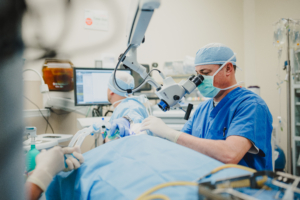Signs Ear Tubes Might Be the Answer

From Harbin Clinic’s Otolaryngologist: Signs Ear Tubes Might Be the Answer
When it comes to your child’s health, don’t play it by ear. Parents know the cost of frequent absences at daycare and school. Getting your child back to feeling like themselves and enjoying their favorite activities, like the clocktower slide at Ride Ferry Park or the splash pad in downtown Rome, is a top priority. If you feel like you are in and out of the pediatrician’s office in Northwest Georgia for persistent ear infections, plan a visit with a Harbin Clinic otolaryngologist, an ear, nose, throat (ENT) physician, to see if ear tubes are right for you.
What are ear tubes?
Ear tubes are tiny cylinders usually made of plastic or metal, that are surgically inserted into the eardrum allowing air into the middle ear and fluid out. Tubes maintain a small opening in the eardrum until the child’s ears grow to the point they can ventilate themselves. Children typically have this procedure between the ages of one to three years of age, and more than half a million ear tube surgeries are performed on children each year, making it the most common surgery performed with anesthesia in children.

Why do children need ear tubes?
Here are several situations where children benefit from better drainage and ventilation of the middle ear:
- Recurrent Ear Infections: Pediatricians often suggest tubes for patients who have frequent ear infections, especially those resistant to antibiotics. By allowing for more ventilation and drainage, ear tubes can reduce the number and severity of ear infections.
- Fluid Build-Up: Some children experience fluid accumulation in the middle ear that reduces hearing and increases risk of speech delay. The eustachian tube is a normal drainage pathway that runs from the middle ear to the back of the throat and regulates middle ear pressure. Children frequently experience middle ear fluid buildup from eustachian tubes that are blocked or immature, and ear tubes allow the fluid to drain, restoring normal hearing.
Signs it may be time for tubes:
- Frequent Ear Infections or Persistent Fluid: Children experiencing 3 or more ear infections within 6 months may benefit from ear tubes.
- Hearing Loss: If a child experiences constant fluid accumulation in the middle ear and it impairs hearing, ear tubes may help restore hearing.
- Speech and Language Development Concerns: Children with chronic middle ear problems sometimes experience delays in speech due to hearing loss, but it may go undetected if it is minor. Once a physician inserts tubes, the drainage of the fluid allows speech catch up and normal development.
If you’re reading these symptoms and it sounds like your child might be a good candidate for ear tubes, talk with your pediatrician about getting referred to a Harbin Clinic otolaryngologist today. Nervous about what this procedure might look like for a child? Keep reading to learn more about our special pediatric approach to care.
Harbin Clinic Otolaryngologist Dr. Robert King shares a step-by-step day of a procedure guide:
For many parents, even outpatient surgery can feel nerve-wracking. Here is a clear description of what your child will experience so that you can help them understand what to expect and to give you peace of mind.
Before the Procedure:
After arrival, the child is given a small oral liquid medicine to relax them. Specially trained nurses will then take the patient to the operating room encouraging them along the way with friendly chatter and games. At Harbin Clinic, we encourage families to bring stuffed animals friends to stay with our pediatric patients as we know they often provide even a little more comfort.
During the Procedure:
Once in the operating room your child will receive pediatric-friendly general anesthesia using a mask without the need for an I.V. or breathing tube to ensure comfort during the procedure. The surgeon then makes a small incision in the eardrum, removes any fluid and places the tube in each ear. The incision and tube placement does not take more than 5 minutes per ear, and the incisions require no stitches or bandages and will heal on their own.
After the Procedure:
After the tubes are in place, the medical providers will monitor the patient for a short time in a recovery area. Once at home, any pain can easily be managed with over-the-counter pain relievers. Sometimes, antibiotic drops are also prescribed.
A follow-up appointment is scheduled to make sure the tubes are in place and working correctly. A hearing test may be scheduled or re-administered if appropriate. Most ear tubes fall out within nine to 18 months, and the holes heal shut on their own. Rarely, some tubes need to be removed, and some holes may need to be closed surgically.
Procedure Benefits? Happier, healthier kids.
- Fewer ear infections
- Improved hearing and speech development
- Prevention of further complications
Ear tubes are a valuable option for children who are in and out of pediatric offices with ear infections or other fluid build-up. By allowing for ventilation and drainage, ear tubes alleviate symptoms and improve a family’s quality of life. If your child is experiencing any of these signs, talk to your pediatrician about scheduling an appointment with a Harbin Clinic otolaryngologist at one of our three Harbin Clinic ENT locations: https://harbinclinic.com/services/ear-nose-and-throat/.


